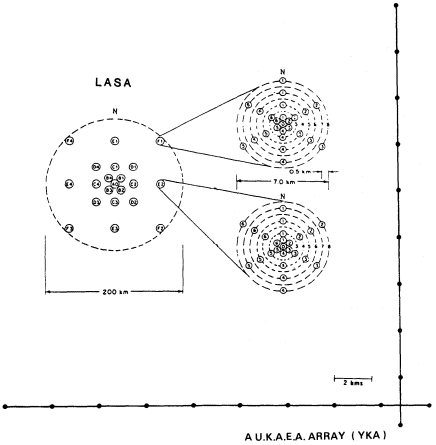Array Deployment in the 1960s
The Geneva recommendations for small arrays as the principal seismological tool for comprehensive test ban (CTB) verification dominated the United States array research program in the ensuing years, although the Berkner Panel also recommended the use of large arrays (for a detailed account of these scientific-political discussions, see Bolt, 1976, chaps. 5 and 6). The first arrays to be deployed were the Wichita Mountain Observatory (WMSO), Unita Basin Observatory (UBSO), Blue Mountain Observatory (BMSO), and Cumberland Plateau Observatory (CPSO), while the Tonto Forest Observatory (TFSO) was significantly larger, as illustrated in figure 1. These arrays were operational for about ten years. Although having excellent site locations, with low noise and high signal sensitivity, these arrays seemingly did not contribute much toward array research. A major drawback was analog recording, which prevented integrated, real-time operation except for vertical stacking (no delay times used). In 1963 the first of the UK-type arrays was completed in Scotland which also used analog recording. The L-shaped configuration of these arrays (fig. 2) gave a rather skewed response pattern but did minimize costly ditching for cables.
The quantum leap in array development came with the construction of the LASA (Montana) array in 1964, achieved in the incredibly short time of just nine months (Anonymous, 1965). The LASA array remained unique on several accounts: its aperture of 200 km (fig. 2), its deployment of 630 shortand long-period seismometers, and, most important, its use of digital signal recording. The second large-aperture array to be constructed was NORSAR, a joint U.S.-Norway venture completed in 1970, with an aperture of 100 km and 196 seismometers (fig. 3). At about the same time, the Gräfenberg array was completed, unique in its use of broadband instruments (Buttkus, 1986).
In summary, the 1960s saw tremendous development in array technologies in terms of new, compact, and high-sensitivity seismometers, data transfer via links and cables over large distances, and ingenious recording systems including digital tapes. However, most of the array recordings were in analog form, thus limiting their use in broader seismological research. An integral part of array deployment was the development of schemes for handling the

Figure 2
The L-shaped Yellowknife, Canada, array and the 200-km aperture LASA,
Montana, array. Each of the twenty-one LASA subarrays initially comprised
twenty-five short-period instruments (later reduced to sixteen) plus one three-
component long-period seismometer.
multichannel data generated, and the theoretical foundation for array data processing as it is known today was laid in the 1960s.